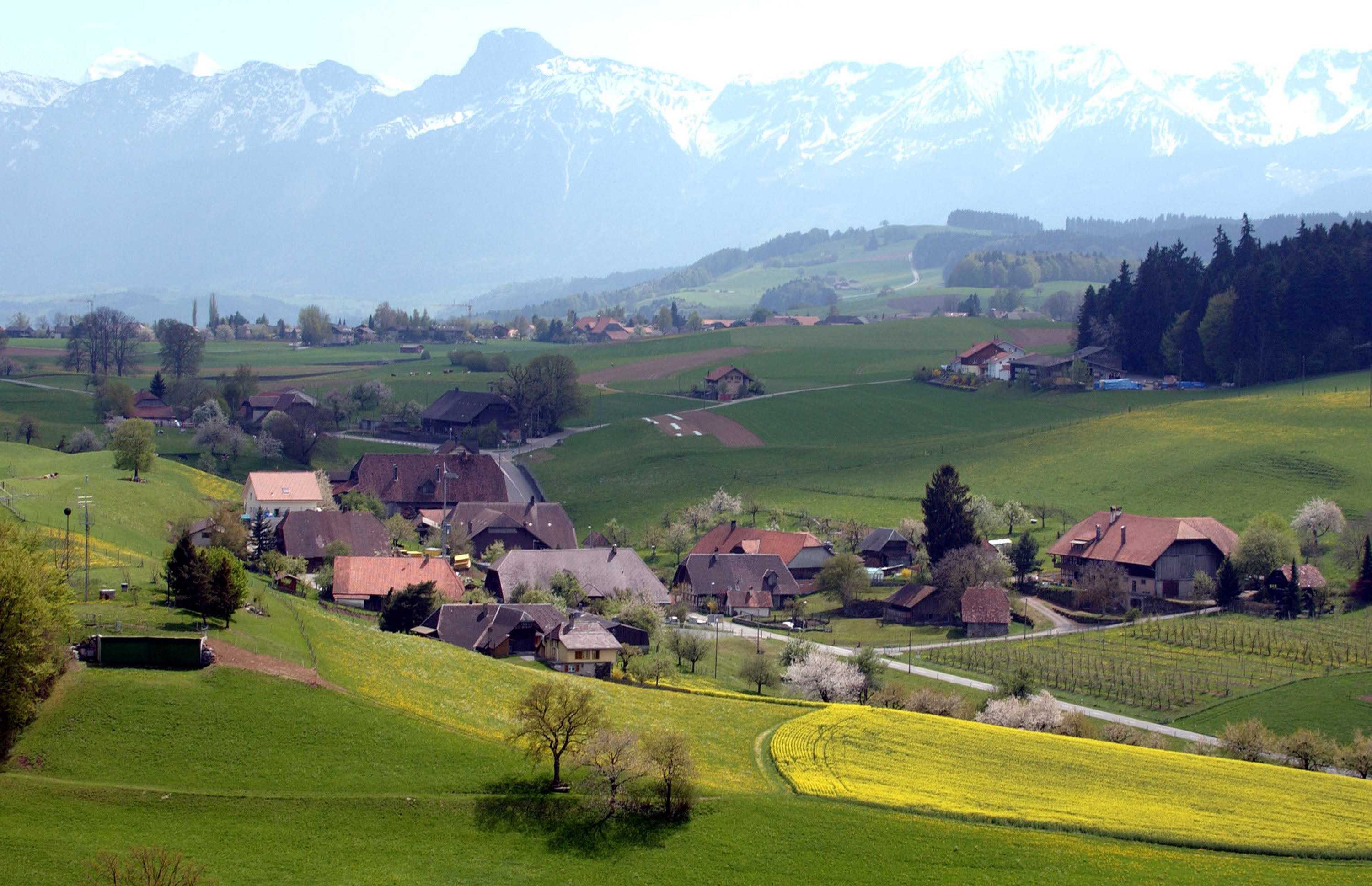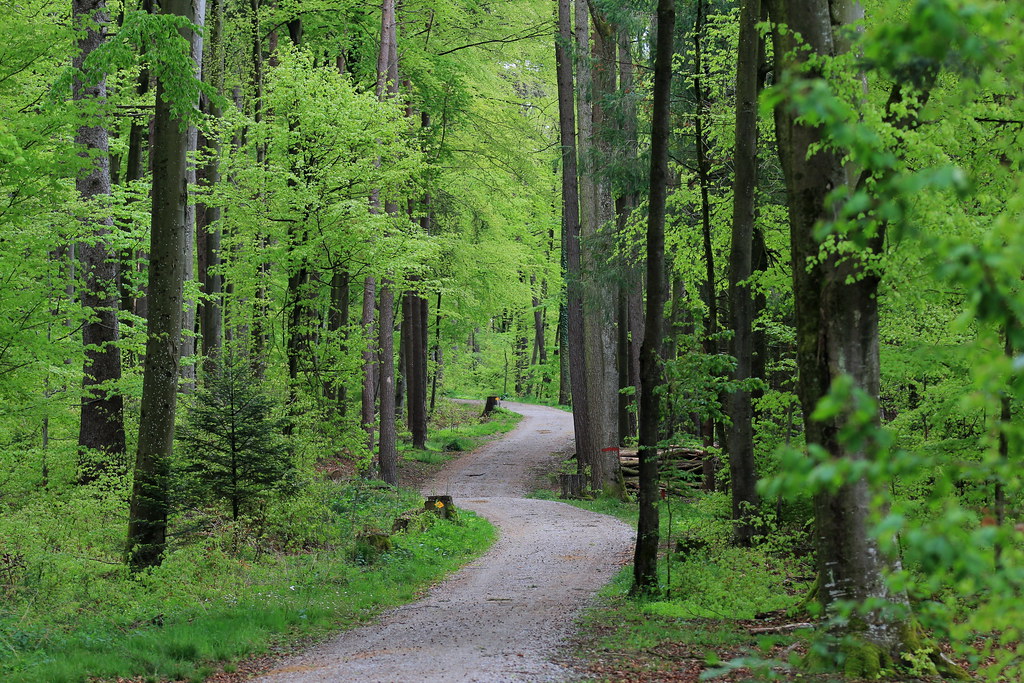Wald, Bern
Englisberg and room forest
Wald is a municipality in the Bern-Mittelland administrative district in the canton of Bern in Switzerland. It was created on 1 January 2004 from the merger of two previously independent municipalities Rooms forest and Englisberg.
Geography
Forest, located at about 840 m above sea level. M., 8 km south of the capital of the canton of Bern ( straight line ). The Its large municipality extends on the plateau of northern Längenberg: a scenic location about 300 m above the level of the Gürbetal, in the higher Bernese Mittelland.
The area of 13.3 km ² large municipality area includes a portion of the length of the mountain. The area was formed during the Ice Age, the ice of the Aaregletschers and therefore shows broadly rounded shapes and different local moraine. Only the extreme west of the area of forest was not covered by ice and has a characteristic relief with numerous short V-shaped valleys and ridges prominent hill (called harrows ) on.
The eastern boundary of the municipality runs mostly on a moraine on the eastern slopes of the length mountain. From here, the communal land on the plateau of Rooms forest (M. 896 m above sea level. ) Extends to the forest heights of Lisiberg ( 972 m above sea level. M. the highest point of the forest ), Kühlewilwald and Englisbergwald to the Hubel ( 945 m above sea. M. ) before the steep drop to Ulmiztal. To the southwest, the area extends over the valley system of the Scherl Ibachs and the amount of Tschuggen (up to 940 m above sea level. M. ) to the Mättibach in the catchment area of the Bütschelbachs (right tributary of the black water ). From the municipality surface 1997 7 % was attributable to settlements, 19 % of forest and woody plants and 74% to agriculture.
Community structure
The community forest consists of the districts:
- Englisberg (820 m above sea level. M., 377 inhabitants in 2000 ), in a valley between the Englisbergegg and the Englisbergwald, with the two hamlets Kühlewil (830 m above sea level. M. ) in a broad trough west of the Englisbergwaldes
- Lower forest (872 m above sea level. M. ) on the saddle between Kühlewilwald and Englisbergwald
- Willi Hold (830 m above sea level. M. ) on the eastern edge of the plateau
- At the church ( 856 m above sea level. M. ) south of the village
- Niederhäusern ( 782 m above sea level. M. ) on the eastern slope of the mountain length
- Winzenried (757 m above sea level. M. ) on a moraine on the eastern slopes of the length of the mountain
- Upper forest (900 m above sea level. M. ) on the edge of Kühlewilwaldes
- Waldhof ( 898 m above sea level. M. ) at the level of the length of the mountain
- Obermuhlern (860 m above sea level. M. ) at the level of the length of the mountain in the headwaters of the Scherl Ibachs
- Egg ( 920 m above sea level. M. ) on the southern slope of the Hubels
- Bumishus (905 m above sea level. M. ) at the level of the south Scherlibachtals
In addition to forest include various groups of farms and individual farms. Neighboring communities of forest are sweeping sentence, Belp, Toffen, Niedermuhlern, Oberbalm and Köniz.
Population
With 1184 inhabitants ( 31 December 2012) Forest is one of the smaller communities of the Canton of Bern. Of the residents 97.7 % are German, 0.6 % French-speaking and 0.5 % speak Italian ( as of 2000). The population of forest amounted in 1850 to 1085 inhabitants, 1900 to 1215 inhabitants. During the 20th century, the population fluctuated always in the range 1170-1280 persons. After a temporary increase to 1342 inhabitants in 1990, a downward trend was recorded again since then.
Economy
Forest was until the second half of the 20th century, a predominantly shaped by the agriculture community. Even today, the dairy industry, animal husbandry and forestry have an important place in the economic structure of the population. Many other jobs are in the local retail industry and the services available. In woods today holdings of horticulture, the electrical industry, car garages and machine shops are represented. However, most important employer in the village is the old-age and nursing home Kühlewil, which was founded in 1892 as a poorhouse to Kühlewyl. In recent decades, the forest has developed into a residential community. Many workers are therefore commuters who work mainly in the agglomeration of Bern.
Traffic
The community is located off the major thoroughfares on a link road of return flow over the length of the mountain to Riggisberg. By Postbus course which operates direct flight from Wabern after Niedermuhlern, Englisberg and room forest are connected to the public transport network.
History
The area of the community forest was probably settled in the 9th century by the Alemanni. Englisberg is first mentioned in 1166 as Endlisperc; the first mention of Rooms forest took place in 1257 under the name Cimberwalt.
In the Middle Ages, the area belonged to the lords of Englisberg, a Kyburg Ministerialengeschlecht. Later, the property was split up and was in the hands of various Bernburger families. Under Bernese rule Englisberg room and forest were under the district court Seftigen. After the collapse of the Ancien Régime (1798 ) were among the two villages during the Helvetic Republic to the District Seftigen and from 1803 to Oberamt Seftigen, which was given the status of an office district with the new cantonal constitution of 1831.
Rooms forest became internationally known through the conference room of the forest, which held from 5 to 8 September 1915, at the Zimmerwaldists manifesto was adopted.
With effect from 1 January 2004, the new community forest (BE) was formed by the merger of the previously independent municipalities Rooms forest and Englisberg.
Attractions
The Church of Forest Room was built from 1697 to 1699, after the forest had room separated from the parish of Belp. In all the villages and hamlets of the commune numerous characteristic farmhouses, Stöckli and memory are preserved in the Bernese style from the 18th and 19th centuries. Is particularly in Obermuhlern a beautiful assembly of houses that were built after the fire of 1780. The former restaurant, which belonged to the Pension Beau Sejour in Room Forest, hosted by 2009 Wind Music Museum. Since 2010, it serves as a private residence. Also, the main building of the inn Beau Séjour, the so-called Villa, in 1915 took place the conference room of the forest, now used as a residence.










